Source: BOCOG
08-08-2008 22:22
Special Report: 2008 Beijing Olympic Games29 colossal burning footprints rise into the sky in a series of fireworks explosions. One second per footprint, 29 of them march along Beijing's central axis all the way to the Olympic Green and National Stadium, symbolize the path of the Games of the XXIX Oympiad and its arrival.
Synopsis: The video screens in the stadium play a short film before the art performance.The short film artistically describes the process of a Chinese scroll painting from papermaking and the four treasures of the study to coloring, mounting the painting and affixing scrolls and indicates the over- all aesthetic style of the art performance.
1. A Chinese painting scroll is opened. It means the performances tonight begin with a Chinese painting scroll.
2. A sheet of white paper is laid in the center of the painting scroll. Papermaking is one of the four great inventions of ancient China.
3. A stream of cultural icons of Chinese historical advancement flows on the painting scroll, including cliff painting, earth pottery and bronze vessel
4. This Guqin (ancient stringed instrument) made more than 1,000 years ago is called "Sounds of Utmost Antiquity."
5. The unique body language of the performers contains the charm of Chinese ink and wash paint- ing. The performances tonight are kicked off with the black and white tone of Chinese ink and wash painting.
6. The performers draw many propitious clouds on the paper. Propitious clouds dissipate magically, leaving only the mountains, rivers and the sun.
11. Painting Scroll
7. On the ground is the famous Chinese ancient painting " A Thousand Li of Rivers and Mountains."
12. Writing
1. Here are the "three thousand disciples" of Confucius. Performers are chanting the much quoted lines of Lunyu (the Analects) -- "All those within the four seas can be considered his brothers."
2. The disciples are holding bamboo slips. They are a kind of books with scripts carved on the stringed bamboo slices.
3. This is a performance of movable-type printing, which is one of the four great inventions of ancient China. 4. The movable-type printing performance takes an image of both ancient character case and modern computer keyboard.
5. This is an ancient Chinese character "He" , which means harmony.
6. This is another type of ancient Chinese character " He" .
7. This is a modern type of Chinese character " He" . All the three words represent not only the evolution process of Chinese characters, but also Confucius idea of humanism, that is, " Harmony is Precious. "
8. The Great Wall is demonstrated by smooth lines, both concise and vivid.
9. Here are peach blossoms, romantic and enjoyable, adequately demonstrating the sweet wish of peace- loving Chinese people.
10. These 897 performers have been trained for more than 10 months. Each of them has his/her own movement sequence, which can be accomplished only by strong memory and diligent practice.
13. Opera
1. This is the percussion performance of traditional Peking Opera of China. As China has a vast territory with numerous dialects, hundreds of traditional operas have been derived.
2. This operatic percussion performance depicts a festive scene of Terracotta soldiers ' triumphant return.
14. Silk Road
1. The performers are advancing, holding the paper. On the ground is the map of the " Silk Road " and the cultural symbols along the road.
2. Now is the performance of the " Silk Road " well known far and near. More than 2,000 years ago, trade caravans of China set out from Chang ' an (today ' s Xi' an of Shaanxi Province) with expensive silk, crossed Hexi Corridor and entered the European continent. Hence, the " Silk Road " became an im- portant passage for economic and cultural exchanges between China and Western countries.
3. Now is the performance of the " Maritime Silk Route " , showing the grandeur of Zheng He ' s voyage to the West.
4. More than 600 years ago, Zheng He of Ming Dynasty led seven shipping fleets with 27,000 people on board on a long voyage starting off from Quanzhou of China and arrived in Western Asia and Eastern Africa, thus creating the well-known " Maritime Silk Route " .
5. This performer holds an ancient compass in his hand. It is one of the four great inventions of ancient China.
15. Music
1. The actor is singing Kunqu, which is an ancient and traditional art and has been selected into world intangible cultural heritage list.
2. On the ground are the five long paintings most famous in China, finished respectively in Tang, Song, Yuan, Ming and Qing Dynasty.
16. Starlight
1. The pianist and the child are offering a romantic tune together, welcoming a brand-new age. This is the Chinese young pianist Lang Lang. The girl playing with him is Li Muzi only 5 years old. She began learning to play the piano at the age of 4.
2. The ancient paintings extend in the endless starlight, indicating a more splendid age of today.
3. The color tone for the modern performance turns from black and white to bright colors.
4.1,000 performers build a "bird 's nest " , towards which a lovely kite flies through in the sky.
17. Nature
17.1 Taijiquan is the most representative shadow boxing in Chinese martial arts, characterized by the “ combina- tion of the dynamic and static and the interdepen- dence of hardness and softness. ”
17.2 The performance via multi-media demonstrates the ancient traditional philosophical concept in Chinese martial arts: the relationship between man and nature.
17.3 “The torrent dropping three thousand feet / straight down to the valley floor / I think it must be the milky way / spilling to the earth from the heavens.”This is the expression of the poetic flavor of the famous lines by Li Bai, a poet during the Tang Dynasty.
17.4 The Eight Diagrams of Taiji symbolize eight natural phenomena, including heaven, earth, thunder, wind, water, fire, mountain and swamp and bringing out the changes of all things on the earth.
17.5 A total of 2,008 Taiji performers form a circle which means grandness and consummation in the traditional Chinese conception. The present array is called “Round Heaven and Square Earth.”
17.6 The children are coloring the ancient Chinese paintings of nature green, expressing the idea of environmental protection which is also the key concept of Taiji - unity of man and nature.
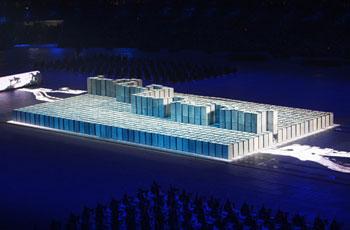 |
| 'movable-type printing'performance |
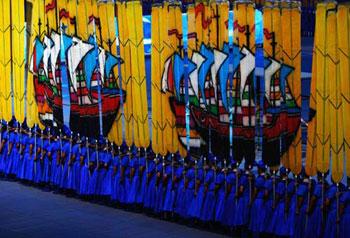 |
| Performers with sailing boats |
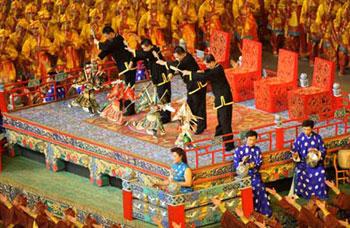 |
| Artist perform |
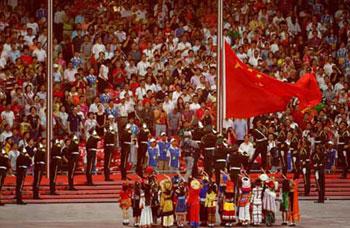 |
| The Chinese flag is raised |
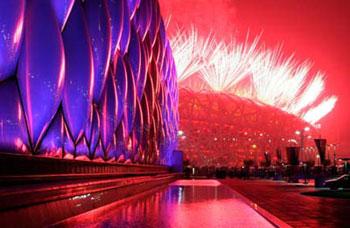 |
| Fireworks |
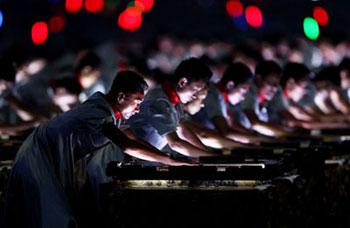 |
| Drummers perform |
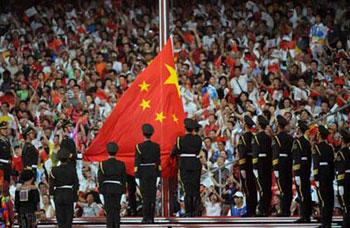 |
| Chinese national flag |
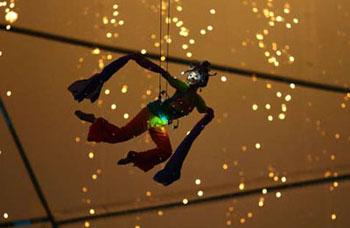 |
| An artist performs |
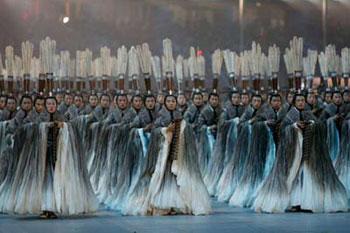 |
| The disciples |
Editor:Wu Yan
